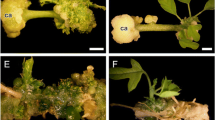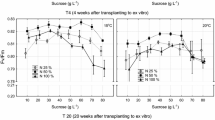Abstract
About 70% of the shoots developed from nodal explants ofGentiana triflora flowered in vitroondouble strength WPM medium containing 3% (w/v) sucrose, 0.5mg/l BA after 12 weeks of culture in a growth room at 22°Cwith continuous illumination (PPFD = 60μmolm−2 s−1). The influences oninvitro shoot development and flowering of several factors includingthe position of the explant, requirements for sucrose, cytokinin orGA3, variations of pH and photosynthetic photon flux density (PPFD)were investigated. In vitro flowering but not shootdevelopment of G. triflora decreased notably withincreaseddistance from the apex of the shoot, indicating the presence of a “floralgradient” in the micropropagated shoots. Conversely, as little as 0.01mg l−1 GA3 in the medium promotedshootdevelopment but even up to 0.2 mg l−1GA3 did not induce in vitro flowering.Even though BA could substitute GA3 for a high level of shootdevelopment, it also promoted a high level of in vitroflowering at the PPFD of 60 μmolm−2 s−1. Sucrose was required for shootdevelopment and flowering in vitro and higher levels ofPPFD could not compensate effectively for the omission of the sugar from themedium. In general, the effects of different concentrations of BA in the mediumor variations of pH on shoot development and flowering invitro were found to be influenced by PPFD. A novel observation isthat precocious flowering of micropropagated gentian shoots did not occur ifthey were first cultured for 5 weeks in the dark before transfer to the lightcondition.
Similar content being viewed by others
References
Carson J.A. and Leung D.W.M. 1994. In vitro flowering and propagation of Wahlenbergia stricta L. N. Z. Nat. Sci. 21: 55–60.
Chang W.C. and Hsing Y. 1980. In vitro flowering of embryoids derived frommature root callus of genseng (Panax ginseng). Nature 284: 341–342.
Dickens C.W.S. and van Staden J. 1988. The in vitro flowering of Kalanchoe blossfeldiana Poellniz. (1) Role of culture conditions and nutrients. J. Exp. Bot. 39: 461–471.
Evans L.T. 1971. Flower induction and the florigen concept. Annu. Rev. Plant Physiol. 22: 365–394.
Fu Y.F., Li H.Y. and Meng F.J. 1995. The possible role of Zearalenone in the floral gradient in Nicotiana tabacum L. J. Plant Physiol. 147: 197–202.
Ivana M., Dragoljub G. and Mirjana N. 1997. Micropropagation of four Gentiana Species, (G. lutea, G.cruciata, G.purpurea and G.acaulis). Plant Cell Tiss. Org. Cult. 49: 141–144.
John C.K. and Nadgauda R.S. 1999. In vitro-induced flowering in bamboos. In vitro Cellular & Devel Biology-Plant 35: 309–315.
Jumin H.B. and Ahmad M. 1999. High-frequency in vitro flowering of Murraga paniculata (L.) Jack. Plant Cell Rep. 18: 764–768.
Jumin H.B. and Nito N. 1995. Embryogenic protoplast cultures of orange Jessamine, (Murraya paniculata) and their regeneration on plant flowering in vitro. Plant Cell Tiss. Org. Cult. 41: 277–279.
Jumin H.B. and Nito N. 1996. In vitro flowering of orange jessamine, (Murraya paniculata (L.) Jack). Experientia 52: 268–272.
Kostenyuk I., Oh B.J. and So I.S. 1999. Induction of early flowering in Cymbidiumniveo-marginatum Mak in vitro. Plant Cell Rep. 19: 1–5.
Kristiansen K., Ornstrup H. and Brandt K. 1999. In vitro PPFD and media composition affect both in and ex vitro performance of Alstroemeria Butterfly-hybrids. Plant Cell Tiss. Org. Cult. 56: 145–153.
Lamproye A., Crevecoeur M., Kevers C. and Gaspar Th. 1987. Multiplication vegetative in vitro de Gentiana lutea et de Gentiana pneumonanthe. Medicina Fec Landbouw Rijksuniv Gentica 52: 1255–1257.
Lang A. 1965. Physiology of flower initiation. In: Ruthland W. (ed.), Encyclopedia of Plant Physiology. Springer-Verlag, New York, pp. 1380–1536.
Lang A. 1987. Nicotiana. In: Halevy A.H. (ed.), Handbook of Flowering VI. CRC, Boca Raton, Fla., pp. 427–483.
Lloyd G. and McCown B. 1980. Commercially-feasible micropropagation of mountain laurel, Kalmia latifolia, by use of shoot-tip culture. Comb. Proc. Intl. Plant Prop. Soc. 30: 421–442.
McDaniel C.N., Sangry H.K. and Singer S.R. 1989. Node counting in axillary buds of Nicotiana tabacum cv Wisconsin 38, a dayneutral plant. Am. J. bot. 76: 403–408.
Mohnen D., Eberhard S., Marfa V., Doubrava N., Toubart P., Gollin D.J. et al. 1990. The control of root, vegetative shoot and flower morphogenesis in tobacco thin cell-layer explants, (TCLs). Development 108: 191–201.
Morgan E.R., Butler R.M. and Bicknell R.A. 1997. In vitro propagation of Gentiana cerina and Gentiana corymbifera. N. Z. J. Crop. Hortic Sci. 25: 1–8.
Scorza R. 1982. In vitro flowering. Hortic Rev. 4: 106–127.
Scorza R. and Janick J. 1980. In vitro flowering of Passiflora suberosa L. J. Am. Soc. Hort. Sci. 105: 982–997.
Sharma N., Chandel K.P.S. and Paul A. 1993. In vitro propagation of Gentianakuroo-an indigenous plant of medicinal importance. Plant Cell Tiss. Org. Cult. 34: 307–309.
Tanimoto S. and Harada H. 1981. Chemical factors controlling floral bud formation of Torenia stem segments cultured in vitro, (1) Effects of minerals, nutrients and sugars. Plant and Cell Physiol. 22: 533–541.
Tran Thanh 1973. Direct flower neoformation from superficial tissue of small explants of Nicotiana tabacum. Planta 115: 87–92.
Viola U. and Franz C. 1989. In vitro propagation of Gentiana lutea. Planta Med. 55: 690.
Wardell W. and Skoog F. 1969. Flower formation in excised tobacco stem segments. Plant Physiol. 44: 1402–1406.
Yamada Y., Shoyama Y., Nishioka I., Kohda H., Namera A. and Okamot T. 1991. Clonal micropropagation of Gentiana scabra Bunge var. buergeri Maxim, and examination of the homogeneity concerning the gentiopicroside content. Chemi. and Pham. Bulle. 39: 204–206.
Yang S.J., Amaki W. and Higuchi H. 1999. Effects of cultivars and ambient environments on in vitro flowering in Kalanchoe blossfeldiana Poellniz. J. Jap. Soci. Hort. Sci. 68: 1170–1177.
Zhang Z. Enhancement of the commercial possibilities of Gentiana Spp. By micropropagation, vase life extension and clone identification. M.Sc., Lincoln University.
Zhang Z. and Leung D.W.M. 2000. A comparison of in vitro and in vivo flowers in Gentain. Plant Cell Tiss. Org. Cult. 63: 223–226.
Author information
Authors and Affiliations
Corresponding author
Rights and permissions
About this article
Cite this article
Zhang, Z., Leung, D.W. Factors influencing the growth of micropropagated shoots and in vitro flowering of gentian. Plant Growth Regulation 36, 245–251 (2002). https://doi.org/10.1023/A:1016588302549
Issue Date:
DOI: https://doi.org/10.1023/A:1016588302549




